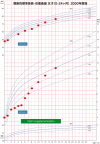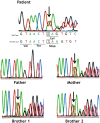A novel NR3C2 mutation in a Japanese patient with the renal form of pseudohypoaldosteronism type 1
- PMID: 27507913
- PMCID: PMC4965512
- DOI: 10.1297/cpe.25.111
A novel NR3C2 mutation in a Japanese patient with the renal form of pseudohypoaldosteronism type 1
Keywords: mineralocorticoid receptor; novel mutation; pseudohypoaldosteronism.
Figures



Similar articles
-
A novel frameshift mutation in NR3C2 leads to decreased expression of mineralocorticoid receptor: a family with renal pseudohypoaldosteronism type 1.Endocr J. 2017 Jan 30;64(1):83-90. doi: 10.1507/endocrj.EJ16-0280. Epub 2016 Oct 5. Endocr J. 2017. PMID: 27725360
-
Two Japanese patients with the renal form of pseudohypoaldosteronism type 1 caused by mutations of NR3C2.Clin Pediatr Endocrinol. 2015 Jul;24(3):135-8. doi: 10.1297/cpe.24.135. Epub 2015 Jul 18. Clin Pediatr Endocrinol. 2015. PMID: 26594094 Free PMC article.
-
Molecular pathogenesis of renal pseudohypoaldosteronism type 1.Expert Rev Endocrinol Metab. 2007 May;2(3):407-419. doi: 10.1586/17446651.2.3.407. Expert Rev Endocrinol Metab. 2007. PMID: 30743803
-
Clinical and molecular features of type 1 pseudohypoaldosteronism.Horm Res. 2009;72(1):1-9. doi: 10.1159/000224334. Epub 2009 Jun 30. Horm Res. 2009. PMID: 19571553 Review.
-
30 YEARS OF THE MINERALOCORTICOID RECEPTOR: Mineralocorticoid receptor mutations.J Endocrinol. 2017 Jul;234(1):T93-T106. doi: 10.1530/JOE-17-0089. Epub 2017 Mar 27. J Endocrinol. 2017. PMID: 28348114 Review.
Cited by
-
Pseudohypoaldosteronism Type 1B and Cohen Syndrome: Novel Mutation, Unusual Combination, and Presentation.Cureus. 2024 Mar 29;16(3):e57217. doi: 10.7759/cureus.57217. eCollection 2024 Mar. Cureus. 2024. PMID: 38681476 Free PMC article.
-
One-month-old girl presenting with pseudohypoaldosteronism leading to the diagnosis of CDK13-related disorder: a case report and review of the literature.J Med Case Rep. 2019 Dec 29;13(1):386. doi: 10.1186/s13256-019-2319-x. J Med Case Rep. 2019. PMID: 31883531 Free PMC article. Review.
-
Clinical features and molecular basis of pseudohypoaldosteronism type 1.Clin Pediatr Endocrinol. 2017;26(3):109-117. doi: 10.1297/cpe.26.109. Epub 2017 Jul 27. Clin Pediatr Endocrinol. 2017. PMID: 28804203 Free PMC article.
References
LinkOut - more resources
Full Text Sources
Other Literature Sources
